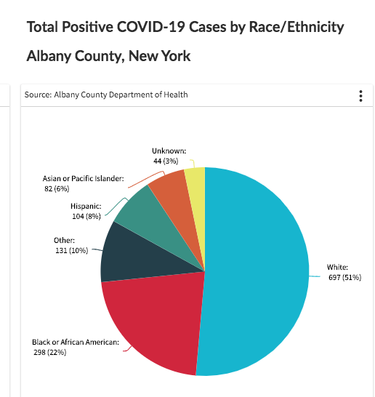Data on COVID-19 shows age and racial disparities
ALBANY COUNTY — Racial and age disparities are pronounced as Albany County continues to gather and display data on COVID-19.
On Monday, Albany County Health Commissioner Elizabeth Whalen, pointing to graphs, maps, and charts on the county’s dashboard, noted that the age groups with by far the most confirmed cases of the coronavirus disease 2019 are residents between the ages of 50 to 59, followed closely by those ages 20 to 29.
Those in the younger group are likely to have mild symptoms or no symptoms, meaning they can unwittingly spread the disease. Only five county residents younger than 25 have been hospitalized and none of them have died of COVID-19.
In fact, no county resident younger than 50 has died of the disease. Twenty-four residents in the 50-to-74 age bracket, or 39.3 percent, have died of COVID-19, although that age group makes up just 29.3 percent of the county’s population.
Thirty-seven of the county residents, or 60.7 percent, have been over the age of 75 although that age group makes up just 7.2 percent of the county’s population.
The vast majority of those who have succumbed to COVID-19 have had underlying health conditions.
When it comes to race, 48 of the county residents who have died, or 78.7 percent have been white while 71.6 percent of the county’s population is white.
For African-Americans, the disparity is even more pronounced. Twelve African Americans, or 19.7 percent, have died of COVID-19 although only 11.4 percent of the county’s population is African American.
Just one hispanic or Latino county resident, or 1.6 percent, has died of COVID-19 while 6.1 percent of the county’s population is hispanic of Latino.
No Asians have died of the disease although they make up 7.0 percent of the county’s population.
No American Indian, Alsakan Native, Native Hawaiian, or other Pacific Islander has died of COVID-19; those groups together make up less than 1 percent of Albany County’s population.
The health department, said Whalen, is “working to make sure we have testing available and education available all across the county to every demographic to make sure everybody is aware of what they can do to prevent their risk and to be tested if they need to.”
Albany County Executive Daniel McCoy said he wants to continue that initiative even when the emergency is over.
Asked about the reason for the racial disparity, Whalen said there are “social determinants” of health. She explained, “People often are living in challenging environments where they’re not able … to prioritize their health so chronic conditions aren’t managed as well as they could be, and sometimes it’s to do with access.”
Whalen said of the county’s health department, “We do a lot of outreach to our high-needs community to try to connect people to care.” But it’s an “ongoing struggle” for public health, she said.
Whalen added, “Social determinants of health are important but they may not be the entire answer with coronavirus. We have to also be looking at biologic reasons and other factors that can contribute, such as epigenetics so there’s a broader context … actively being studied.”
Epigenetics is the study of changes in organisms caused by modification of gene expression rather than alteration of the genetic code itself.
Whalen concluded, “We just don’t have the answers.”



